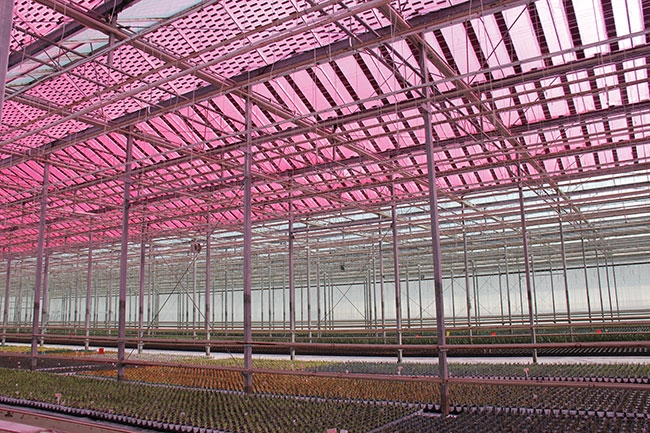
Features
Greenhouses
Structures & Equipment
Dual use for solar modules
May 6, 2019 By Greta Chiu
 The half-acre trial installation at Freeman Herbs tests the ‘racing stripe’ pattern (near the back of the photo) against the ‘checkerboard’ pattern (near the front). Photo credit: Greenhouse Canada
The half-acre trial installation at Freeman Herbs tests the ‘racing stripe’ pattern (near the back of the photo) against the ‘checkerboard’ pattern (near the front). Photo credit: Greenhouse CanadaThere’s something different about the glass at Freeman Herbs – it’s pink.
Above a half acre of Freeman’s production space, the southern-facing panes of rooftop glass have been replaced with specialty solar modules. Each one combines two key pieces of technology: a light-polarizing backsheet and a photovoltaic (PV) cell, explains Patrick Gossage, product innovation & business development manager at Heliene, an Ontario-based solar technology manufacturer.
The polyurethane backsheet filters out green light while enhancing red and blue wavelengths for the plants below. Red and blue wavelengths have previously been shown to elicit positive effects on plant growth, and form the basis for a number of horticultural LED technologies.
The PV cells serve a different function. They take in light from the sun and green light filtered from the pink backsheets, converting both into electricity for greenhouse use. These are bifacial solar cells, adds Gossage. “They generate electricity from both sides, not just at the top where the light strikes it. If there’s reflection from the ground up or [from] another surface, it will generate electricity.”
The glass itself is solar glass, which diffuses and spreads out the incoming light, regardless of the angle of the sun. It helps minimize the shading effect of these solar cells, explains Gossage, while reducing the chances of crop burn under high light conditions.
In states like Massachusetts and California, land that was owned specifically for agriculture has been completely replaced by solar farms. They’re no longer productive from an agricultural standpoint, explains Gossage. By putting these solar modules on greenhouses, agricultural land can now generate electricity while continuing to grow produce.
Having conducted a number of smaller trials throughout North America, this installation at Freeman Herbs is by far the largest. “We’ve got 600 modules and these were all retrofitted into the existing 25-year-old greenhouse,” says Gossage. Unlike traditional solar technologies, the modules are integrated to become the actual roof of the building. It wasn’t easy with glass that had been there for over 20 years, he laughs.
Heliene is in the process of testing two different PV cell arrangements to study their impact on crop growth. One is a ‘racing stripe’ pattern, placing full PV cells in a linear fashion. The second is made of full PV cells cut into quarters and arranged in a ‘checkerboard’ configuration to minimize shading. Both take up about a third of the module space, leaving the rest of the light to filter down to the crop. However, the full cells are slightly more cost-effective from a manufacturing standpoint, explains Gossage, so they can be sold at a lower price point. The quarter cells are also more fragile to handle.
“Our hypothesis is that, because of the solar glass diffusing the light and the height of the ceiling of the greenhouse, the same amount of light should penetrate both designs,” says Gossage. “We should see no real difference in terms of crop growth, but we still need to test that.”
Over the course of this year, Niagara College will be conducting a detailed analysis on the data collected at Freeman Herbs. It’ll be interesting to see how different crops respond under different light conditions and module configurations, says Gossage.
The half-acre trial is predicted to generate five to 10 per cent of the total energy needs through this 66-kilowatt system. As to the potential cost savings offered by the technology, Gossage says it’ll differ depending on the facility, cost of electricity, and light levels, among other considerations. “The value proposition will be higher in areas where energy is more expensive,” he explains, adding that Heliene will be looking to partner with greenhouse projects in native communities, where the cost of energy is extremely high.
Print this page